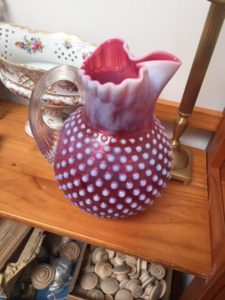 PK has a cranberry opalescent hobnail water pitcher with a clear blown glass applied handle. “Hobnail” is a stud of glass that imitates the old “boot” soles of the era. Many late 19th and early 20th century glass factories produced such knobby glass, notably Fenton Art Glass and Westmoreland Glass. The hobnail style persisted to the mid-20th century from the Fenton Factory.
PK has a cranberry opalescent hobnail water pitcher with a clear blown glass applied handle. “Hobnail” is a stud of glass that imitates the old “boot” soles of the era. Many late 19th and early 20th century glass factories produced such knobby glass, notably Fenton Art Glass and Westmoreland Glass. The hobnail style persisted to the mid-20th century from the Fenton Factory.
My mother collected the Fenton Milk Glass (white) Neo-Early American milk glass, and these decorative and primarily useless objects in white with hobnail sell for under $5 today. I’m thinking here of the milk glass ‘hen’ box, which opens in the hen’s middle. We had one, and nothing was ever placed inside. Fenton, during my mom’s era, specialized in reproduced American glass designs from the 19th century. PK’s pitcher is indeed an antique, however.
PK’s pitcher originally was from a whole set, meant for serving lemonade, in cranberry glass with white hobnails on the surface. Usually the more knobby protruding the bumps, the earlier the glass. Almost every late Victorian American bride was gifted a lemonade set of a pitcher and matching tumblers. Some of these were expensive. Moser Glass of Bohemia made some great sets, and were enameled in floral designs.
Why were these sets fashioned of colored glass? Lemonade, at the time this pitcher was manufactured (1910), was homemade, using hand pressed lemon juice, water, and cane sugar or honey, and therefore produced a cloudy liquid. Clear glass may emphasize the cloudiness, and colored glass was considered more appetizing. American lemonade was not carbonated, as opposed to the British traditional fizzy lemonades, such as those made by Britvic.
Like everything gastronomical, the French pioneered lemonade
The 17th century Compagnie de Limonadiers of Paris were itinerant vendors who served the populace lemonade from tanks mounted on their backs. Today, Parisians enjoy Citron Presse, unmixed portions of pressed lemons, syrup, and water, to be personally mixed. Almost all cultures have a tradition of drinking some kind of lemon mixture, going back to Egyptian times.
Thus, PK’s lemonade pitcher set originally comprised seven pieces, one pitcher and six tumblers, of the same cranberry hobnail glass. Finding a complete sets is rare, as the glass of course is fragile. Pieces break after 100 years! Not only that, once carbonated soft drinks entered the market, non-carbonated homemade lemonade fell out of favor, and these once mandatory household entertaining sets became a thing of the past.
Enter Carbonated Beverages
The famous scientist Joseph Priestly discovered a method of carbonating mineral water in 1767. His findings were published in a paper quaintly entitled ‘Impregnating Water with Fixed Air,’ describing carbonated water made from sulfuric acid, chalk, and mineral water.
Johann Jacob Schweppe, founder for the Schweppes Company, in 1783 sold carbonated Geneva water in Switzerland before he immigrated to London. By 1851, for the Great Exhibition in London, the Schweppes Company installed a huge soda water fountain at the entrance to the Exhibition held at the giant Crystal Palace. Schweppes carbonated drinks were the ‘official’ beverage of the Exhibition.
In America in the early 19th century, the soda fountain at the drug store became a fixture, and for some, a routine. People considered carbonated water healthy in those days. All that changed, making lemonade sets as well as soda fountains obsolete. In 1870 a glass bottle, strong and inventive enough, employing a marble blown inside, was developed. Libby Glass Company then later made a new bottle, which made the marble stopper in the neck obsolete, when the company developed a way of mass-producing glass bottles that previous to 1899 had to be hand blown.
PK’s pitcher, therefore, once part of a set, tells a short and sweet history of American beverages. The rarity of a lemonade set, not produced today, tells the history of the mass consumption and popularity of carbonated sugar drinks. In 2012, Americans spent 65 billion on soft drinks, the household average annual spending on such drinks was $850.
Gone are the simple lemonade days, even though some cities in our country want to outlaw carbonated sugary drinks, and return to the lemonade set. As early 20th century thought leader Elbert Hubbard coined it, “When life serves you lemons, make lemonade.” Yes, Elbert really coined that phrase! And Elbert was from the era of the lemonade hostess set himself. He would be surprised to learn that PK’s pitcher is worth $200, a set would sell for $350.
Pingback: High Culture Eagle Devolves to Low Culture Symbol - Elizabeth Appraisals